Bednorz W. (ed.) Advances in Greedy Algorithms
Подождите немного. Документ загружается.


Heuristic Algorithms for Solving Bounded Diameter Minimum Spanning Tree Problem and Its
Application to Genetic Algorithm Development
371
T ← {(v0,v1)};
U ← U − {v1};
C ← C ∪ {v1};
depth[v1] ← 0;
}
while (U ≠ ∅) {
v ← random(U);
u ← argmin {c(x,v): x ∈ C};
T ← T ∪ {(u,v)};
U ← U − {v} ;
depth[v] ← depth[u] + 1;
if (depth[v] < [k/2])
C ← C ∪ {v} ;
}
return T;
Raidl and Julstrom proposed a genetic algorithm for solving BDMST problems which used
edge-set coded (G.R. Raidl & B.A. Julstrom, 2003) (JR-ESEA) and permutation-coded
representations for individuals (B.A. Julstrom & G.R. Raidl, 2003) (JR-PEA). Permutation-
coded evolutionary algorithms were reported to give better results than edge-set coded, but
usually are much more time consuming. Another genetic algorithm, based on a random key
representation, was derived in (B.A. Julstrom, 2004), sharing many similarities with the
permutation-coded evolutionary algorithms. In (M. Gruber & G.R. Raidl, 2005), Gruber used
four neighbourhood types to implement variable neighbourhood local search for solving the
BDMST problem. They are: arc exchange neighbourhood, level change neighbourhood,
node swap neighbourhood, and center change level neighbourhood. Later, (M. Gruber et al.,
2006), re-used variable neighbourhood searches as in (M. Gruber & G.R. Raidl, 2005),
embedding them in Ant Colony Optimization (ACO) and genetic algorithms for solving the
BDMST problem. Both of their proposed algorithms (ACO and GA) exploited the
neighbourhood structure to conduct local search, to improve candidate solutions. In (Nghia
& Binh, 2007), Nghia and Binh proposed a new recombination operator which uses multiple
parents to do the recombination in their genetic algorithm. Their proposed crossover
operator helped to improve the minimum and mean weights of the evolved spanning trees.
More recently, in (A. Singh & A.K. Gupta, 2007), Alok and Gupta derived two
improvements for RGH heuristics (given in (G.R. Raidl & B.A. Julstrom, 2003)) and some
new genetic algorithms for solving BDMST problems (notably the GA known as PEA-I).
RGH-I in (A. Singh & A.K. Gupta, 2007) iteratively improves the solution found with RGH
by using level change mutation. It was shown in (A. Singh & A.K. Gupta, 2007) that RGH-I
has better results than all previously-known heuristics for solving the BDMST problem.
PEA-I employs a permutation-coded representation for individuals. It uses uniform order-
based crossover and swap mutation as its genetic operators. PEA-I was shown to be the best
GA of all those tried on the BDMST problem instances used in (A. Singh & A.K. Gupta,
2007). In (Binh et al., 2008a), Binh et al., also implement another variant of RGH, which is
called RGH
1
. RGH
1
is similar to RGH, except that when a new vertex is added to the
expanding spanning tree, it is chosen at random, and connected to a randomly chosen
vertex that is already in the spanning tree.

Advances in Greedy Algorithms
372
3. New greedy heuristic algorithm (center-based recursive clustering)
Our new greedy heuristics is based on RGH in (G.R. Raidl & B.A. Julstrom, 2003) and NRGH
in (Nghia and Binh, 2007), called CBRC. We extend the concept of center to every level of the
partially constructed spanning tree. The algorithm can be seen as recursively clustering the
vertices of the graph, in that every in-node of the spanning tree is the center of the sub-
graph composed of nodes in the subtree rooted at this node. It is inspired from our
observation (and other such as in (A. Abdalla et.al, 2000), (G.R. Raidl and B.A. Julstrom,
2003) that good solutions to the BDMST problem usually have “star-like structures” as can
be seen (for a Euclidean graph) in Figure 1.
In a star-like structure, the vertices of the graph are grouped in clusters, and the clusters are
connected by a link between their centers. Pseudocode for the new heuristic based on this
observation, known as Center-Based Recursive Clustering (CBRC), is presented below:
1. T ← ∅;
v
0
← Choose_a_Center(V)
U ← V − {v
0
};
C ← {v
0
};
depth[v
0
] ← 0;
If k is odd then
{
v
1
← Choose_a_Center(U)
T ← {(v
0
, v
1
)};
U ← U − {v
1
};
C ← C ∪ {v
1
};
depth[v
1
] ← 0;
}
2. //Group vertices in U into cluster(s)
//with centers at v
0
or v
1
For each node w in U do
{
If k is even then
{
w becomes child of v
0
;
depth[w]=1;
T ← T ∪ {(w,v
0
)};
}
Else // k is odd
If Distance(w,v
0
) ≤ Distance(w,v
1
) then
{
w becomes child of v
0
;
depth[w]=1;
T ← T ∪ {(w,v
0
)};
}
Else
{
w becomes child of v
1
;
depth[w]=1;
T ← T ∪ {(w,v
1
)};
}
} //end for
3. Loop
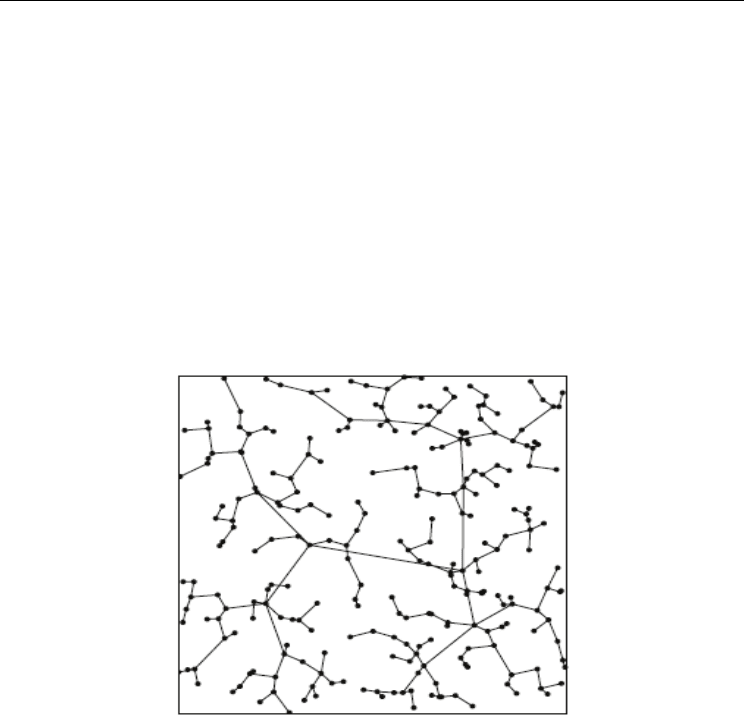
Heuristic Algorithms for Solving Bounded Diameter Minimum Spanning Tree Problem and Its
Application to Genetic Algorithm Development
373
V= set of leaves in U with depths < ⎣k/2⎦;
v= Choose_a_Center(V);
if(v is empty)
Break; // Jump out of the loop
U = U
−
{v};
For each leaf node w in U do
{
If Distance(w,v) ≤ Distance(w, parent(w)) then
w becomes child of v;
depth[w]=depth[v] +1;
T=T -{(w,parent(w))}+{(w,v)};
}
The algorithm above is a general framework for CBRC. It employs two abstract functions,
namely, Choose_a_Center and Distance. The implementations of these functions are expected
to affect the performance of the heuristics, and the best choice could depend on the problem
instance. We propose below some possible implementations of these two functions.
Fig. 1. A “star-like” structure of a typical solution to the BDMST problem.
Implementations of Choose_a_Center function:
- v is a center of U if ∑w∈U Distance(v, w) → min. If there is more than one such v then
choose from them randomly.
- Rank all vertices in U according to ∑w∈U Distance(v, w), then choose v randomly from
the first h% of the vertices.
- Conduct h-tournament selection, ∑w∈U Distance(v, w) as the vertex for v.
- Choose v randomly (i.e. it does not depend on Distance at all).
Implementations of the Distance function:
- Distance(u, v) = c(u, v).
- Distance(u, v) = cost the of shortest path between u and v (used for Non-Eclidean
graphs).
It can be seen from the pseudo-code of CBRC that none of the combinations of Distance and
Choose_a_Center from the above implementations increase the asymptotic computational
complexity of the heuristic to more than O(n
3
). It is also possible to apply post-

Advances in Greedy Algorithms
374
improvement, as proposed in (A. Singh and A.K. Gupta, 2007) to CBRC just as for RGH. The
resulting heuristic is known as CBRC-I. In the next section, CBRC is tested on some
benchmark Euclidean instances of the BDMST problem.
4. Proposed genetic algorithm
Genetic algorithm has proven effective on NP-hard problem. Much works research on NP-
hard problem, particularly in problems relating to tree have been done. Several studies
proposed representations for tree (J.Gottlieb et al., 2000), (G.R.Raidl & B.A.Julstrom, 2003),
(B.A.Julstrom & G.R.Raild, 2003), (B.A.Julstrom, 2004), (Martin Gruber et al., 2006), (Franz
Rothlauf, 2006). This section presents the genetic algorithm for solving BDMST problem.
4.1 Initialization
Use OTTC, RGH
1
, CBRC, RGH heuristic algorithms described above for initializing
population and edge list for chromosome code.
4.2 Recombination operator
Using k-recombination operator as in (Nghia and Binh, 2007).
4.3 Mutation operator
Using four mutations operators: edge delete mutation, center move mutation, greedy edge
replace mutation, subtree optimize mutation as in (G.R.Raidl & B.A.Julstrom, 2003).
5. Computational results
5.1 Problem instances
The problem instances used in our experiments are the BDMST benchmark problem
instances used in (G.R. Raidl & B.A. Julstrom, 2003), (A. Singh & A.K. Gupta, 2007), (Nghia
& Binh, 2007), (Binh et al., 2008a) . They are Euclidean instances. All can be downloaded
from http://www.sc.snu.ac.kr/~xuan/BDMST.zip. Euclidean instances are complete
random graphs in the unit square. We chose the first five instances of each problem size on
Euclide instances (number of vertices) n = 100, 250, 500, and 1000, the bounds for diameters
being 10, 15, 20, 25 correspondingly (making up 20 problem instances in total).
5.2 Experiment setup
We created two sets of experiments. In the first set of experiment, we compare the
performance of the heuristic algorithms: OTTC, RGH, RGH
1
, CBRC. The detail of the
comparison between other heuristic algorithm for solving BDMST problem such as CBTC,
RGH-I, CBRC-I can be refered to (Binh et al., 2008b), (A. Singh and A.K. Gupta, 2007).
There are several heuristic algorithms for solving BDMST problem as mentioned above but
no research has concerned with their effectiveness in application to develop hybrid genetic
algorithm. Therefore, in second set of experiment, we will try to fix this problem.
In the second set of experiment, we tested six genetic algorithm algorithms for solving
BDMST problem. All of the genetic algorithms use recombination and mutation operator
mentioned in section 4 but initialized by different heuristic algorithm. GA
1
, GA
2
, GA
3
uses

Heuristic Algorithms for Solving Bounded Diameter Minimum Spanning Tree Problem and Its
Application to Genetic Algorithm Development
375
CBRC, OTTC, RGH
1
algorithm correspondent for initializing the population. GA
4
uses
CBRC, OTTC, RGH
1 ,
RGH for initialization the population with the same rate for each
heuristic. GA
5
uses RGH
1
, CBRC for initializing, the rate of them in the population are 30 and
70. GA
6
uses RGH
1
, OTTC, CBRC for initializing, the rate of them in the population are 35, 35
and 30.
GA
1
GA
2
GA
3
GA
4
GA
5
GA
6
CBRC
100% 0% 0% 25% 70% 30%
RGH
0% 0% 0% 25% 0% 0%
OTTC
0% 100% 0% 25% 0% 35%
RGH
1
0% 0% 100% 25% 30% 35%
Fig. 2. The rate of the heuristic algorithms use for initialization of the population in each
experiment genetic algorithm
5.3 System setting
In the first experiment, the system was run 300 times for each instances. In the second
experiment, the population size for GA
1
, GA
2
, GA
3
, GA
4
, GA
5
, GA
6
was 100. The number of
generations was 500. All GAs populations used tournament selection of size 3 and crossover
rate of 0.5. The mutation rates for center level change, center move, greedy edge mutation,
and subtree optimize mutation were 0.7, 0.2, 0.8, and 0.5 respectively.
Each system was allocated 20 runs for each problem instance. All the programs were run on
a machine with Pentium 4 Centrino 3.06 GHz CPU using 512MB RAM.
5.4 Results of computational experiments
The experiment shows that:
- Figure 3, 4, 5, 6, 7, 8, 9, 10, 11 show that the proposed heuristic algorithm, called CBRC
have the best result than RGH, OTTC, RGH
1
. It means that the solution found by CBRC
algorithm is the best solution in comparison with the other known heuristic algorithm
for solving BDMST problem on all the instances with n = 100, 250, 500 and 1000 (n is the
number of vertices).
- Figure 15 shows that the best solution found by GA
1
have better result about 22% than
the CBRC which is used for initialization the population in GA
1
on all 20 problem
instances.
- Figure 16 shows that sum up of the best solution found by GA
2
have better result about
approximately four times than the OTTC which is used for initialization the population
in GA
2
on all 20 problem instances.
- Figure 17 shows that sum up of the best solution found by GA
3
have better result about
over 10 times than the RGH
1
which is used for initialization the population in GA
3
on all
20 problem instances.
- Figure 11 shows that sum up of the best solution found by CBRC have better result
about 6.5 times than the OTTC and 17 times than RGH
1
while the the figure 18 shows
that sum up of the best solution found by GA
1
have better result about 0.8% times than
the GA
2
and approximately 2% than GA
3
.
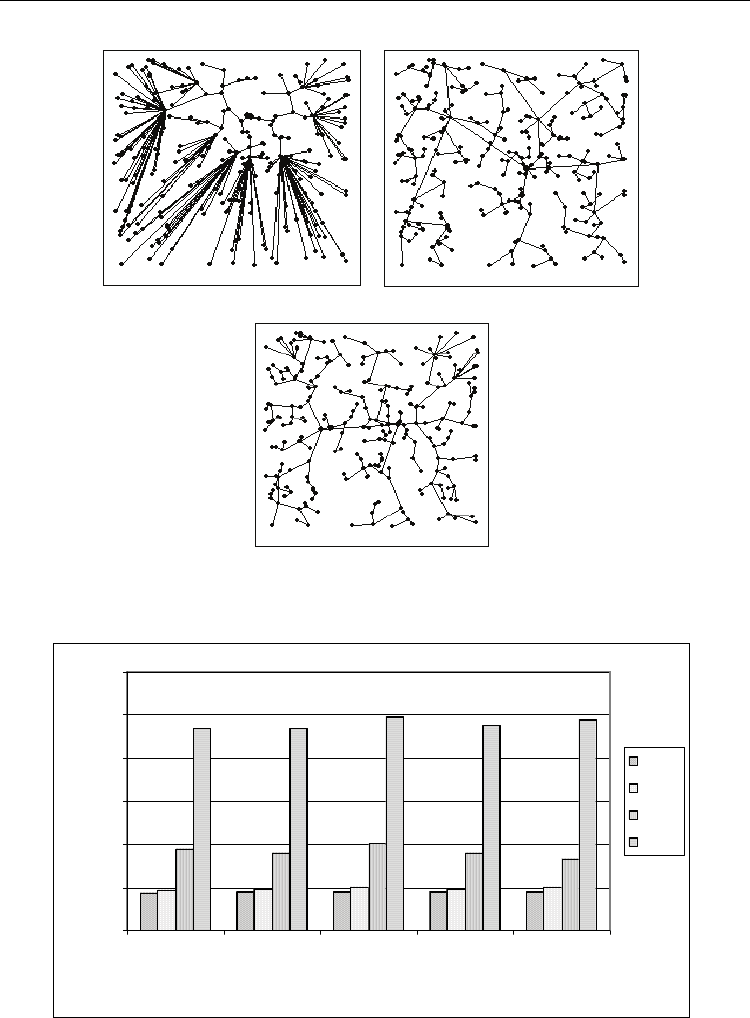
Advances in Greedy Algorithms
376
a)
b)
c)
Fig. 3. The best solution found by the heuristics: OTTC, RGH and CBRC on the problem
instance with n = 250 and k = 15, test 1:
(a) OTTC, weight=42.09; (b) RGH, weight=15.14; (c) CBRC, weight = 13.32.
0
10
20
30
40
50
60
12345
Index of instances
Weight of tree
CBRC
RGH
OTTC
RGH1
Fig. 4. The best solution found by the four heuristics: CBRC, RGH, OTTC, RGH
1
on the
problem instance with n = 100 and k = 10.
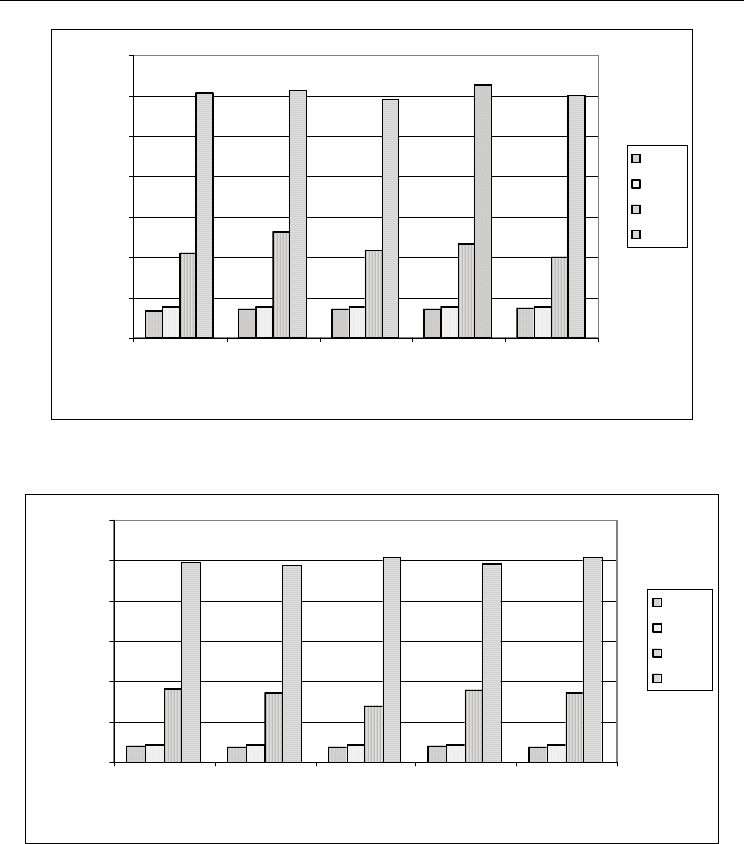
Heuristic Algorithms for Solving Bounded Diameter Minimum Spanning Tree Problem and Its
Application to Genetic Algorithm Development
377
0
20
40
60
80
100
120
140
12345
Index of instances
Weight of tree
CBRC
RGH
OTTC
RGH1
Fig. 5. The best solution found by the four heuristics: CBRC, RGH, OTTC, RGH
1
on the
problem instance with n = 250 and k = 15
0
50
100
150
200
250
300
12345
Index of instances
Weight of tree
CBRC
RGH
OTTC
RGH1
Fig. 6. The best solution found by the four heuristics: CBRC, RGH, OTTC, RGH
1
on the
problem instance with n = 500 and k = 20.
- Figure 18 shows that among GA
1
, GA
2
, GA
3
, GA
4
, GA
5
, GA
6
, sum up of the best solution
found by GA
6
have bettest result than the other, otherwise GA
3
have worest result.
- Figure 19 shows that GA
1
have smallest sum of standard deviation otherwise GA
3
have
largest sum of standard deviation.
- Figure 20 shows that among GA
1
, GA
2
, GA
3
, GA
4
, GA
5
, GA
6
, the number of instances
found best result by GA
5
and GA
6
are biggest otherwise the number of instances found
best result by GA
2
and GA
3
are smallest.
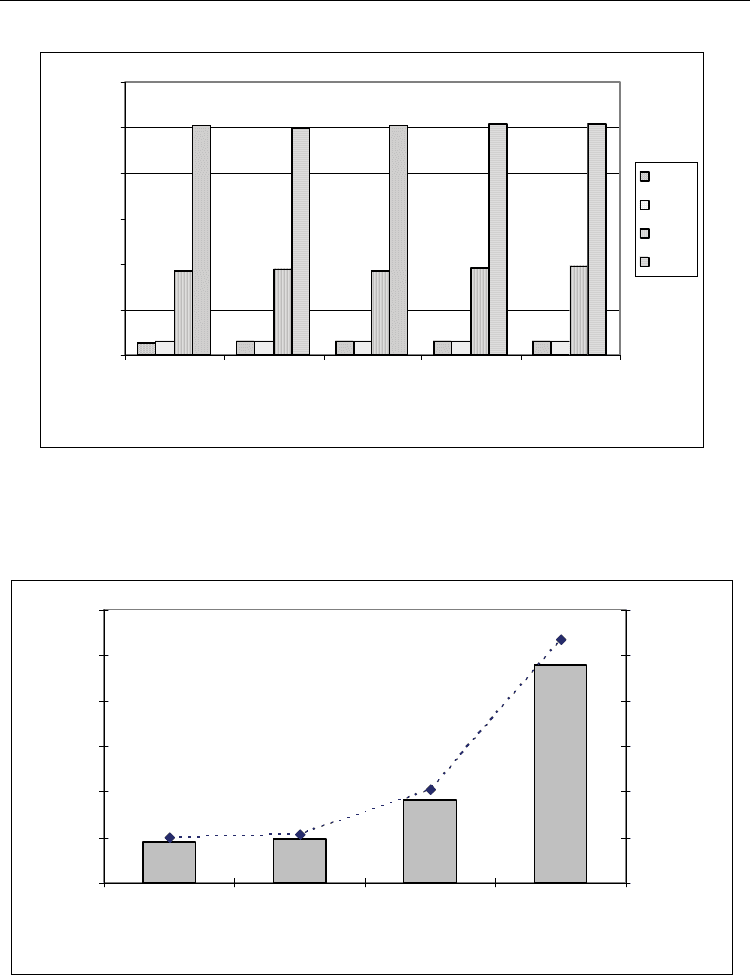
Advances in Greedy Algorithms
378
0
100
200
300
400
500
600
12345
Index of instances
Weight of tree
CBRC
RGH
OTTC
RGH1
Fig. 7. The best solution found by the four heuristics: CBRC, RGH, OTTC, RGH
1
on the
problem instance with n = 1000 and k = 25.
100.0%
107.1%
203.5%
535.2%
0
50
100
150
200
250
300
CBRC RGH OTTC RGH1
Algorithm
Weight of tree
0%
100%
200%
300%
400%
500%
600%
Percentage
Fig. 8. Comparision of the best solution found by the four heuristics: CBRC, RGH, OTTC,
RGH
1
on all the problem instance with n = 100 (5 instances), k = 10
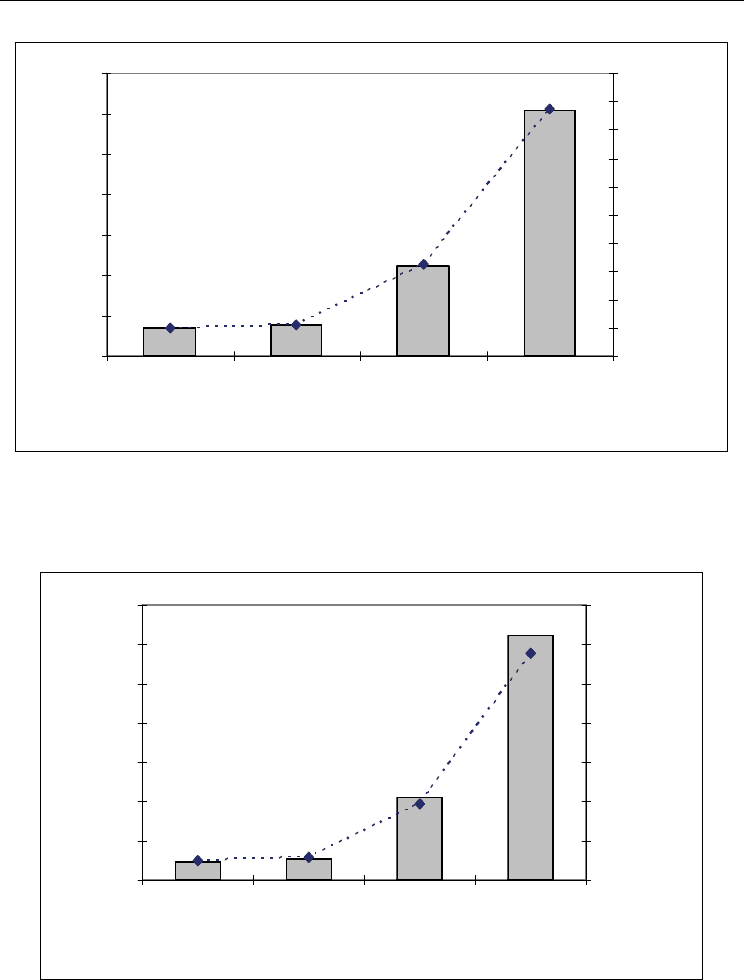
Heuristic Algorithms for Solving Bounded Diameter Minimum Spanning Tree Problem and Its
Application to Genetic Algorithm Development
379
100.0%
109.6%
321.8%
873.3%
0
100
200
300
400
500
600
700
CBRC RGH OTTC RGH1
Algorithm
Weight of tree
0%
100%
200%
300%
400%
500%
600%
700%
800%
900%
1000%
Percentage
Fig. 9. Comparision between the best solution found by the four heuristics: CBRC, RGH,
OTTC, RGH
1
on all the problem instance with n = 250 (5 instances), k = 15
100%
115%
1154%
389%
0
200
400
600
800
1000
1200
1400
CBRC RGH OTTC RGH1
Algorithm
Weight of tree
0%
200%
400%
600%
800%
1000%
1200%
1400%
Percentage
Fig. 10. Comparision between the best solution found by the four heuristics: CBRC, RGH,
OTTC, RGH
1
on all the problem instance with n = 500 (5 instances) , k = 20
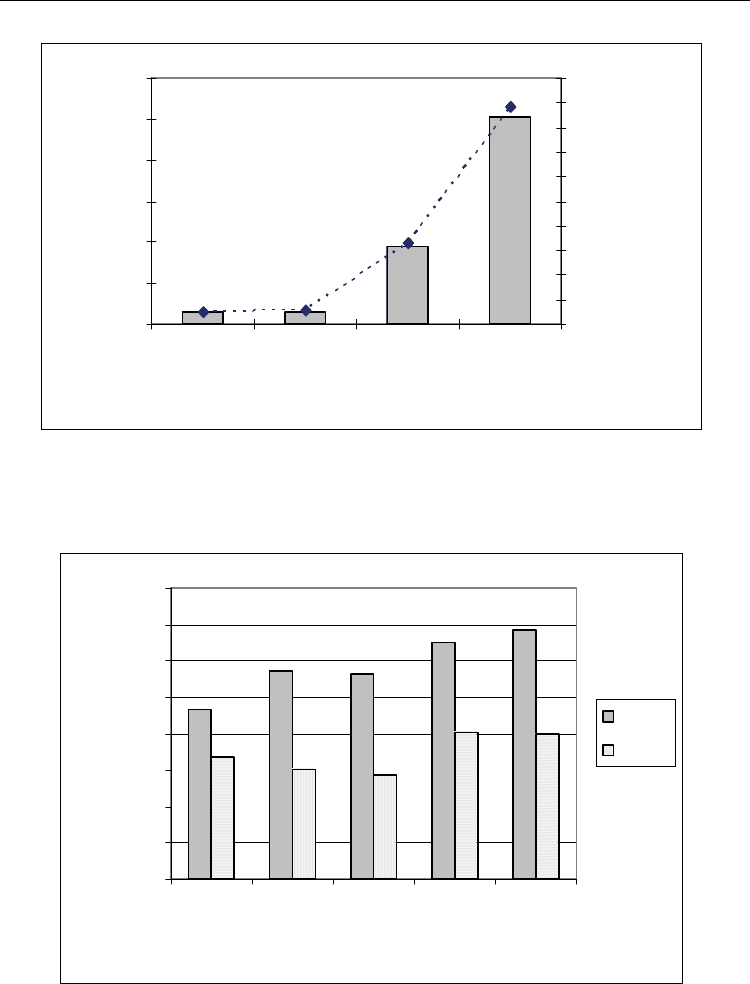
Advances in Greedy Algorithms
380
100.0%
107.6%
657.8%
1758.0%
0
500
1000
1500
2000
2500
3000
CBRC RGH OTTC RGH1
Algorithm
Weight of tree
0.0%
200.0%
400.0%
600.0%
800.0%
1000.0%
1200.0%
1400.0%
1600.0%
1800.0%
2000.0%
Percentage
Fig. 11. Comparision between the best solution found by the four heuristics: CBRC, RGH,
OTTC, RGH
1
on all the problem instance with n = 1000 (5 instances) , k = 25
11
11.5
12
12.5
13
13.5
14
14.5
15
12345
Index of instances
Min weight of tree
CBRC
GA1
Fig. 12. The best solution found by the CBRC and GA
1
on all the problem instance with n =
250, k = 15
